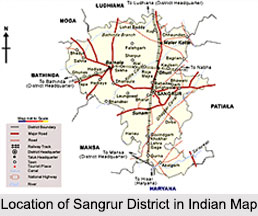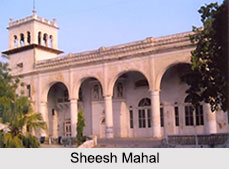 Sangrur District is one of the southern districts of Punjab. It lies between 29 degree 4 minutes and 30 degree 42 minutes north latitude and 75 degree 18 minutes and 76 degree 13 minutes east longitude. Sangrur District is bounded by Ludhiana District and Ferozepur District in the north, by Bathinda District in the west, by Patiala District in the east and by Jind District of Haryana in the south. The district in general is rural region in the southern part of the State. Sangrur District does not have any place of tourist interest, although there are a few places of some historical or religious importance.
Sangrur District is one of the southern districts of Punjab. It lies between 29 degree 4 minutes and 30 degree 42 minutes north latitude and 75 degree 18 minutes and 76 degree 13 minutes east longitude. Sangrur District is bounded by Ludhiana District and Ferozepur District in the north, by Bathinda District in the west, by Patiala District in the east and by Jind District of Haryana in the south. The district in general is rural region in the southern part of the State. Sangrur District does not have any place of tourist interest, although there are a few places of some historical or religious importance.
History of Sangrur District
Sangrur District takes its name from its headquarters town, Sangrur. It is said to have been founded almost 400 years back. Excavations show that Sangrur District has association with the ancient Harappan civilization. Formerly, Sangrur District was a division of Nabha state and it became an independent district in the year 1948. Sangrur District comprises parts of a few erstwhile distinct administrative units of Jind, Malerkotla; and some parts of Ludhiana.
Climate of Sangrur District
The climate of the district is basically dry and is characterized by a short monsoon, a hot summer and a bracing cold winter. The year may be divided into four seasons. The cold season from November to March is followed by the hot season lasting up to the end of June. The period from July to mid-September constitutes the rainy season, of south-west monsoon, the second half of September and October may be termed as the post-monsoon or transition period. During the south-west monsoon season the relative humidity is high. It is comparatively drier during the rest of the year. On an average, there are 27 rainy days in a year in Sangrur District. Winds are generally light but do gain some strength during the late summer and early part of the monsoon season. However, Sangrur District is scarcely affected by monsoon depressions.
 Demography of Sangrur District
Demography of Sangrur District
Total population of Sangrur District as per 2001 Census is 2000173. The sex ratio according to census 2001 is 874 females per thousand male in district. 69.95 percent population is literate whereas the rate of male and female literacy is 75.63 percent and 63.55 percent respectively. Sangrur District occupies an area of 502417 hectares. In terms of area the district ranks third in the state after Ferozepur and Faridkot Districts.
Administration of Sangrur District
From Administrative point of view Sangrur District is divided into five tehsils namely Sangrur, Sunam, Malerkotla, Barnala and Moonak. These tehsils have been further divided into 13 blocks - Malerkotla-I, Malerkotla-II, Dhuri, Sherpur, Mehal Kalan, Sehna, Barnala, Sangrur, Bhawanigarh, Sunam, Lehra, Andana and Moonak. Total number of villages in Sangrur District is 697, out of which, number of inhabited villages is 693 and number of un-inhabited villages is 4. Administration of Sangrur District is headed by Deputy Commissioner with the aid of his assistant officers.
Tourism near Shangrur District
Popular tourist attractions in Shangrur District are Sheesh Mahal, Banasar Garden, Gurdwara Janam Asthan, Gurdwara Nanak Jhira Sahib and Gurdwara Akoi Sahib. Some of these places have been discussed in brief below:
Sheesh Mahal: Sheesh Mahal or the Palace of Mirrors is 58 km away from the Sangrur city. The palace got its name from the beautiful mirror works in it. The palace is surrounded by gardens, terraces, fountains and artificial lake. It was built by Maharaja Narinder Singh in the year 1845 and later it was served as the residence of the Nawab of Malerkotla.
Gurdwara Nanak Jhira Sahib: It is located around 18 km away from Sangrur in Kanjla village.
Gurdwara Akoi Sahib: This gurdwara is located at a distance of 5 km north of Sangrur city. It was visited by the first, sixth and ninth Sikh gurus.
Visiting Information to Sangrur District
Sangrur, the headquarters of the district administration is directly linked by road with Chandigarh, Ludhiana, Budhlada, Delhi, Sultanpur and Gurdaspur. It is also directly linked by rail with Ludhiana and Jhakhal (in Haryana). All the municipal towns of the district except Bhadaur, Bhawanigarh, Dhanaula and Longowal have railway stations. Ludhiana Airport is the nearest airport to Sangrur District. National Highway 19 connects this district to other major cities of India.



















